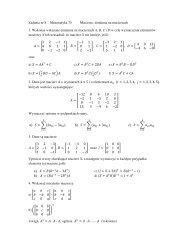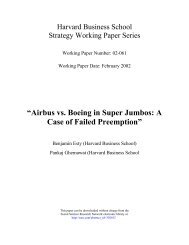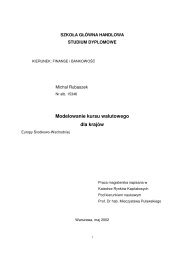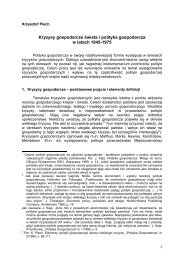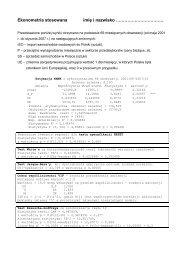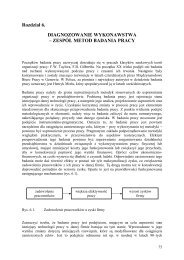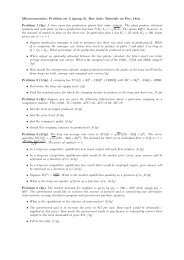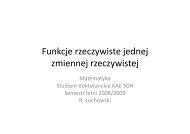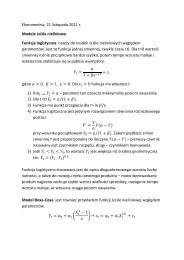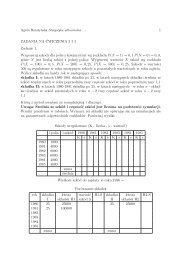Problem sets for Microeconomics II [110051-0471]
Problem sets for Microeconomics II [110051-0471]
Problem sets for Microeconomics II [110051-0471]
Create successful ePaper yourself
Turn your PDF publications into a flip-book with our unique Google optimized e-Paper software.
3 Production and cost analysis<br />
Exercise 3.1. Suppose that production function of the steelworks is given by Q =<br />
5LK, where L is the number of workers, and K is the amount of capital used to<br />
give Q units of steel daily. Steelwork can hire labor at $10 per unit, and the cost<br />
of capital is $20 per unit.<br />
What is the optimal mix of inputs to produce 40 units of steel<br />
Exercise 3.2. The owner of the “Magic car wash” describes the relation between<br />
number of cars washed and labor input as follows: Q = −.8 + 4.5L − .3L 2 , where<br />
Q is the number of cars washed per hour, and L is the number of employees. For<br />
each car washed the owner gets $5, and he pays $4.5 per hour to his employees.<br />
a. How many persons should the owner employ to maximize profit<br />
b. What is the profit per hour<br />
c. Is the above labor to cars washed relation true <strong>for</strong> all L Explain.<br />
Exercise 3.3. Firm Z is developing a new product. An early introduction (beating<br />
rivals to market) would greatly enhance the company’s revenues. However, the<br />
intensive development ef<strong>for</strong>t needed to expedite the introduction can be very<br />
expensive. Suppose total revenues and costs associated with the new product’s<br />
introduction are given by R = 720 − 8t and C = 600 − 20t + .25t 2 , where t is the<br />
introduction date (in months from now).<br />
a. Some executives have argued <strong>for</strong> an expedited introduction date 12 months<br />
from now (t = 12). Do you agree<br />
b. How about instant introduction (t = 0) What introduction date is most profitable<br />
Explain.<br />
Exercise 3.4. In a particular region, there are two lakes rich in fish. The quantity<br />
of fish caught in each lake depends on the number of persons who fish in each,<br />
according to Q 1 = 10N 1 − .1N1 2 and Q 2 = 16N 2 − .4N2 2, where N 1 and N 2 denote<br />
the number of fishers at each lake. In all, there are 40 fishers.<br />
a. Suppose N 1 = 16 and N 2 = 24. At which lake is the average catch per fisher<br />
greater In light of this fact, how would you expect the fishers to redeploy<br />
themselves<br />
6


![Problem sets for Microeconomics II [110051-0471]](https://img.yumpu.com/32645692/6/500x640/problem-sets-for-microeconomics-ii-110051-0471.jpg)

